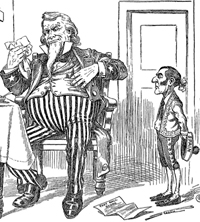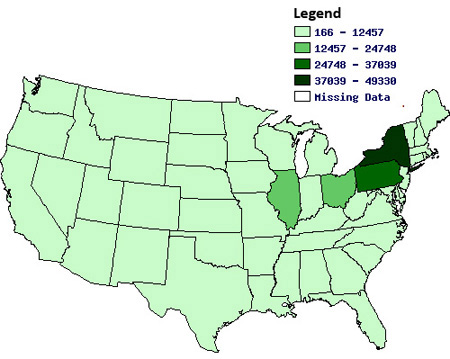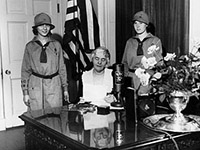American Personalities: Uncle Sam and Lady Liberty
Uncle Sam and Lady Liberty—for over a century, these two characters have personified the United States and popular conception of the nation’s ideals. Answer these questions about the roles these characters have played, including soldier, tyrant, police officer, financier, judge, deity, and champion of the oppressed.
1. What characters have political cartoonists used to represent the English counterparts to Uncle Sam and Lady Liberty?
c. John Bull and Britannia.
 Wearing breeches and a Union Jack waistcoat, John Bull once served as the symbol for the British everyman, but evolved into a symbol of the country as a whole. Both Britannia, the goddess-like female figure of England, and John Bull often appeared in political cartoons with Uncle Sam or Columbia—another name for Lady Liberty.
Wearing breeches and a Union Jack waistcoat, John Bull once served as the symbol for the British everyman, but evolved into a symbol of the country as a whole. Both Britannia, the goddess-like female figure of England, and John Bull often appeared in political cartoons with Uncle Sam or Columbia—another name for Lady Liberty.
2. This version of Uncle Sam appeared in a Denver Evening Post cartoon in November 1898. Uncle Sam is usually drawn as a skinny character. Why is he fat here?
b. He has just finished consuming overseas territories, such as Hawaii, Puerto Rico and the Philippines.
 In a spree of imperialism, the United States, represented by Uncle Sam, has "consumed" Hawaii (annexed to the U.S. on July, 1898), as well as Puerto Rico and the Philippines (though the Treaty of Paris and the acquisition of these as territories was still in debate in November 1898). Now, Uncle Sam turns to the figure of Spain—the cartoon's caption has him say, "Now, young man, I'll attend to your case." With the Spanish-American War over, the glutted U.S. prepares to attend to Spain itself, not just its colonies.
In a spree of imperialism, the United States, represented by Uncle Sam, has "consumed" Hawaii (annexed to the U.S. on July, 1898), as well as Puerto Rico and the Philippines (though the Treaty of Paris and the acquisition of these as territories was still in debate in November 1898). Now, Uncle Sam turns to the figure of Spain—the cartoon's caption has him say, "Now, young man, I'll attend to your case." With the Spanish-American War over, the glutted U.S. prepares to attend to Spain itself, not just its colonies.
3. When did political cartoonists draw Uncle Sam as a self-appointed global policeman?
d. During the "Imperialist" phase of U.S. foreign affairs, beginning prior to the Spanish-American War.
 In the years leading up to the Spanish-American War and the U.S. metamorphosis into an imperialist world power, Uncle Sam was often drawn as a police officer. However, cartoonist Thomas Nast had already pictured Uncle Sam as a cop on the beat, policing U.S. political corruption, as early as 1888.
In the years leading up to the Spanish-American War and the U.S. metamorphosis into an imperialist world power, Uncle Sam was often drawn as a police officer. However, cartoonist Thomas Nast had already pictured Uncle Sam as a cop on the beat, policing U.S. political corruption, as early as 1888.
4. When Uncle Sam first appeared, he was drawn to resemble:
a. An old gentleman in knee breeches.
 For several decades, Uncle Sam was indistinguishable from an earlier character, Brother Jonathan, who also represented the U.S., superceding Yankee Doodle. By the middle of the 19th century, the same figure-by then clad in striped pants, short jacket, and top hat—was sometimes called Uncle Sam and sometimes Brother Jonathan. By about 1875, "Brother Jonathan" had mostly disappeared.
For several decades, Uncle Sam was indistinguishable from an earlier character, Brother Jonathan, who also represented the U.S., superceding Yankee Doodle. By the middle of the 19th century, the same figure-by then clad in striped pants, short jacket, and top hat—was sometimes called Uncle Sam and sometimes Brother Jonathan. By about 1875, "Brother Jonathan" had mostly disappeared.
5. When Columbia first appeared, she most closely resembled:
a. The goddess of liberty, Libertas.
 Often depicted in the French Revolution, Libertas wore a soft "liberty" or "Phrygian" cap. As Columbia, she could also wear feathers on her head, a reference to Native Americans, or a star or crown. The name "Columbia" fell out of popularity after World War I, and the character gained the names "Miss Liberty" or "Lady Liberty."
Often depicted in the French Revolution, Libertas wore a soft "liberty" or "Phrygian" cap. As Columbia, she could also wear feathers on her head, a reference to Native Americans, or a star or crown. The name "Columbia" fell out of popularity after World War I, and the character gained the names "Miss Liberty" or "Lady Liberty."
The Library of Congress, as part of its American Treasures exhibit, looks at the history of the famous "I Want You" World War I image of Uncle Sam. It also showcases an image, by the same artist, of Lady Liberty.
Uncle Sam and Lady Liberty have appeared regularly in political cartoons since their creation. Vassar College's 1896: The Presidential Campaign includes a subsection just for cartoons containing Uncle Sam, as does Leo Robert Klein's The Red Scare (1918-1921) (see "Uncle Sam" under subject headings). Even Dr. Seuss took his turn drawing Uncle Sam: Try June 1942 in Dr. Seuss Went to War: A Catalog of Political Cartoons. You might also try a search for the term "uncle sam" in the New York Public Library's Digital Archive.
Once you've found some resources picturing these iconic personifications, take a look at Understanding and Interpreting Political Cartoons in the History Classroom for models of classroom use.
- "Have Your Answers Ready," 1917, Library of Congress, Prints and Photographs Collection (accessed November 12, 2009).
- James Baillie, "Uncle Sam and his servants" (New York: 1844), Prints and Photographs Collection, Library of Congress (accessed November 12, 2009).







 The Institute for Dynamic Educational Advancement (IDEA) offers an
The Institute for Dynamic Educational Advancement (IDEA) offers an 


 The map of the 1920 concentration of manufacturing establishments was generated by the University of Virginia Library's
The map of the 1920 concentration of manufacturing establishments was generated by the University of Virginia Library's 

 True. Or at least, he is recorded as doing so in colonist Robert Beverley's 1705 The History and Present State of Virginia, today a major resource in early Virginian and colonial history. Beverley gives a full account of Pocahontas's story (though historians debate its accuracy). According to Beverly, in England,
True. Or at least, he is recorded as doing so in colonist Robert Beverley's 1705 The History and Present State of Virginia, today a major resource in early Virginian and colonial history. Beverley gives a full account of Pocahontas's story (though historians debate its accuracy). According to Beverly, in England, False. Upon coming to the throne in 1891—following the death of her brother, King Kalakaua—Queen Lili'uokalani appointed Victoria Ka'iulani Cleghorn, her half-Scottish half-Hawaiian niece, as Crown Princess of Hawaii. Born in 1875 and educated in the UK, Ka'iulani spent the latter part of her short life advocating for the restoration of her country's independence. She died of illness in 1899, at the age of 23—shortly after the U.S. officially annexed Hawaii. The Hawaiian royal line continues today, but Ka'iulani was the last princess appointed while the monarchy held political power.
False. Upon coming to the throne in 1891—following the death of her brother, King Kalakaua—Queen Lili'uokalani appointed Victoria Ka'iulani Cleghorn, her half-Scottish half-Hawaiian niece, as Crown Princess of Hawaii. Born in 1875 and educated in the UK, Ka'iulani spent the latter part of her short life advocating for the restoration of her country's independence. She died of illness in 1899, at the age of 23—shortly after the U.S. officially annexed Hawaii. The Hawaiian royal line continues today, but Ka'iulani was the last princess appointed while the monarchy held political power.  False. The imperial family objected to the opening of Japan—which had kept its borders largely shut to outsiders for centuries—to the U.S., but the imperial princess' marriage did not take place until several years after the shogun concluded a second treaty, this one with the first U.S. Consul General to Japan, Townsend Harris. The shogunate, essentially a monarchy made up of warrior-rulers, had long held the power of government in Japan, while the traditional monarchy of the imperial family had become largely ceremonial. However, the shogunate's agreeing to open the country to Westerners in the treaties of 1854 and 1858 created a political divide between supporters of the shogun and of the emperor; Kazunomiya's marriage to Iemochi in 1862 was meant to bridge this divide.
False. The imperial family objected to the opening of Japan—which had kept its borders largely shut to outsiders for centuries—to the U.S., but the imperial princess' marriage did not take place until several years after the shogun concluded a second treaty, this one with the first U.S. Consul General to Japan, Townsend Harris. The shogunate, essentially a monarchy made up of warrior-rulers, had long held the power of government in Japan, while the traditional monarchy of the imperial family had become largely ceremonial. However, the shogunate's agreeing to open the country to Westerners in the treaties of 1854 and 1858 created a political divide between supporters of the shogun and of the emperor; Kazunomiya's marriage to Iemochi in 1862 was meant to bridge this divide. To read Robert Beverley's full account of the life of Pocahontas, refer to pages 25-33 of his The History and Present State of Virginia
To read Robert Beverley's full account of the life of Pocahontas, refer to pages 25-33 of his The History and Present State of Virginia 

 [Question 1] The first photograph of either a president or a first lady broadcasting from the White House is of Mrs. Hoover. She began national broadcasts in 1929, even setting up a practice room in the White House where she could "improve [her] talkie technique." Many of her broadcasts were made from President Hoover's country retreat, Camp Rapidan, where she often devoted her programs to speaking to young people, urging girls to contemplate independent careers and boys to help with the housework. Mrs. Hoover had a degree in geology from Stanford University, as did her husband. She had accompanied him to China for two years, where he hadsupervised the country's mining projects. She later used the Mandarin Chinese she learned then to communicate with her husband privately when they were in the presence of others.
[Question 1] The first photograph of either a president or a first lady broadcasting from the White House is of Mrs. Hoover. She began national broadcasts in 1929, even setting up a practice room in the White House where she could "improve [her] talkie technique." Many of her broadcasts were made from President Hoover's country retreat, Camp Rapidan, where she often devoted her programs to speaking to young people, urging girls to contemplate independent careers and boys to help with the housework. Mrs. Hoover had a degree in geology from Stanford University, as did her husband. She had accompanied him to China for two years, where he hadsupervised the country's mining projects. She later used the Mandarin Chinese she learned then to communicate with her husband privately when they were in the presence of others. [Question 4] Julia Grant, although it happened after her husband was no longer president. Mrs. Grant went down the Big Bonanza silver mine in Virginia City, Nevada with her husband after hearing that he had wagered that she would be afraid to go. The Grants, along with their son, Ulysses, Jr., visited the mine on October 28, 1879, more than two years after Grant had left office. The mine's fabulous production of silver during the Civil War had done much to undergird the Government's financial credit internationally. Lucy Hayes later descended into the same mine with her husband, President Rutherford Hayes. On May 21, 1935, Eleanor Roosevelt made the national news by visiting the Willow Grove coal mine in Bellaire, Ohio, to observe the working conditions of the miners.
[Question 4] Julia Grant, although it happened after her husband was no longer president. Mrs. Grant went down the Big Bonanza silver mine in Virginia City, Nevada with her husband after hearing that he had wagered that she would be afraid to go. The Grants, along with their son, Ulysses, Jr., visited the mine on October 28, 1879, more than two years after Grant had left office. The mine's fabulous production of silver during the Civil War had done much to undergird the Government's financial credit internationally. Lucy Hayes later descended into the same mine with her husband, President Rutherford Hayes. On May 21, 1935, Eleanor Roosevelt made the national news by visiting the Willow Grove coal mine in Bellaire, Ohio, to observe the working conditions of the miners. [Question 7] Lyndon Johnson, with his wife Lady Bird on one side and Jackie on the other, was sworn in aboard Air Force One less than two hours after JFK's assassination. The ceremony was delayed to wait for Jackie to arrive. The most famous photograph of the event has Jackie in the foreground, standing in a pink suit still stained with her husband's blood, with LBJ in the center with his hand upraised taking the oath, and with Lady Bird in the background.
[Question 7] Lyndon Johnson, with his wife Lady Bird on one side and Jackie on the other, was sworn in aboard Air Force One less than two hours after JFK's assassination. The ceremony was delayed to wait for Jackie to arrive. The most famous photograph of the event has Jackie in the foreground, standing in a pink suit still stained with her husband's blood, with LBJ in the center with his hand upraised taking the oath, and with Lady Bird in the background.
